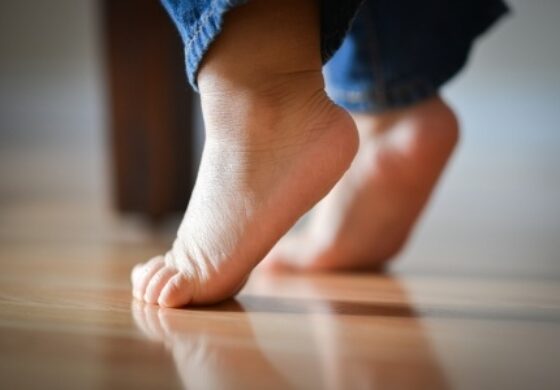There is nothing quite like watching your little one take his or her first steps. This little human who has been exploring their world on hands and knees is now toddling around upright! As pediatric physical therapists, we are often present for this achievement and exciting milestone!
In our experience, many parents have two concerns when it comes to walking: their child wearing shoes and toe walking.
“Maybe if she had some hard-bottomed shoes on it would help with her balance.” This could not be further from the truth!
New walkers must be able to feel the ground beneath their feet in order to develop balance reactions, fuel their sensory systems, and strengthen the muscles in their feet.
Some parents are also concerned about germs or injuries that could result from being barefoot, when in reality, our skin is a barrier against microorganisms and can be toughened by walking barefoot.
The Strong + Fabulous Foot1, 2
Do you ever stop to think about how our feet support the entire weight of our body as we walk, jump, dance, run, and explore our world?
Our feet are made up of 28 bones and have almost as many joints as our hands, making the possibilities for movement endless. Our feet also have more nerve endings than any other part of the body and their interaction with the environment is important for building neurological pathways in the brain and strengthening our sensory and proprioceptive systems.
Proprioception is the body’s awareness of its position and movement in space and is obtained through information from receptors in joints and muscles. If we cover our children’s feet in shoes, we are eliminating opportunities for their brains to grow new neural connections.

Normal Foot Development3, 4
Many parents become concerned when they observe that their new walker has “flat feet”. Not to worry, as this is completely normal!
The arch on the inside of the foot, also known as the medial longitudinal arch, is not present at birth and this area consists of a fat pad early on. The development of the medial longitudinal arch occurs between 2 to 6 years old and is not fully developed until 6 years of age.
Almost all new walkers have a flexible flatfoot, meaning the arch is not visible in weight bearing postures, such as standing, but can be observed in non-weight bearing positions, such as sitting.
If you are concerned about your child’s foot posture, you can perform this quick test to confirm that your child does indeed have a flexible flatfoot. Observe his/her foot shape in sitting (foot free from the floor) and also when he/she is standing on tiptoes. If you observe an arch on the inside of the foot in these two positions but not in weight bearing (standing), then your child has a flexible flatfoot.
One Area of Abnormal Foot Development Is Toe Walking
Podiatrists believe that structural and functional changes in the foot can result from having to conform to the shape and constriction of a shoe, rather than being allowed to develop naturally.6 And the younger the foot, the greater the potential for damage.6
As pediatric physical therapists, we often see kiddos begin to toe walk early on. Toe walking refers to a walking pattern in which a child walks on the balls of their feet, with no contact between the heels and the ground.
Initially, toe walking is not cause for too much concern. Typically by 3 years of age, we want to see children walk with a heel-toe pattern, rather than toe walking.
Potential Causes of Toe Walking
There are many medical causes or reasons for toe walking. Our main focus for today is on what is called idiopathic toe walking.
Idiopathic toe walking occurs when a child walks on the balls of their feet for an unknown reason. This diagnosis is only used after a child has been evaluated and other medical causes have been ruled out.
Typically toe walking is exaggerated when bare-foot or when walking on surfaces that have increased tactile sensations (carpet, cold tile, grass).
Contributing factors that may cause the development of toe walking in children include:
- Flexibility of leg and foot muscles
- Altered proprioceptive processing (sensing the body’s position in space)
- Overall body strength
- Visual processing
- Tactile processing (increased response to touch sensation)
- Vestibular processing (maintaining balance)
Treatment Options for Toe Walking

There are many different options to treating toe walking. Below are a few things you can do at home with your little ones to help promote normal walking development.
Have your child engage in sensory experiences both indoors and outdoors barefoot, such as jumping in puddles, walking through a pile of crunchy leaves, walking across dry and wet sand at the beach, and feeling different textures throughout the home with their feet. This will increase the number of developing neural connections between their feet and their growing brains.
Walking barefoot across uneven surfaces, such as pebbles, slippery ground, or up or downhill, can assist with balance reactions and strengthening the muscles and ligaments of the feet. Being barefoot allows the toes to grip the floor to help with balance. Further, the arch on the inside of the foot is strengthened by rising up onto tiptoes, an action which can only be fully achieved when barefoot. When your child is barefoot, he/she will also feel less inclined to look down when she walks as she can already feel the floor beneath her using her sensory system.
If at home activities are not showing improvement than further treatment may be warranted. Many parents bring their kiddos in for toe walking and expect a quick fix. However, depending on how old and how long your child has been toe walking determines how quickly it can be resolved.
In order to determine an appropriate treatment protocol, a comprehensive history and evaluation should be completed by a pediatric physical therapist.
Below is a list of different treatment options available for children who display idiopathic toe walking.
- Occupational Therapy: sensory integration strategies
- Physical Therapy: stretching, strengthening, and gait training
- Orthotics: plastic splints to be worn on ankles/feet to maintain stretch/flexibility of the Achilles’ tendons
- Serial Casting: series of casts to stretch the Achilles’ tendons
- Orthopedic Surgery: surgical procedure to lengthen the Achilles’ tendon (heel cord)
Inevitably, there will be times when you will want to put a shoe on your toddler, such as when exploring a public park or walking along a city sidewalk. In these cases, I would recommend a lightweight, flexible sneaker. I tell parents to find a shoe that they can easily bend in half to ensure that the sole is flexible enough. But remember, barefoot is best for your little one in order to support the development of his/her musculoskeletal and nervous systems. Your little one loves to play in the dirt, mud, and puddles and will feel even more connected to her play if she can participate with her feet!
Getting a head start on treatment for toe walking is very important. If you are noticing my toe walking in your child, please reach out and schedule a free physical therapy consult.
Sources:
- Pica, Rae. “Shed those shoes: Being barefoot benefits brain development and more!” Rae Pica Keynotes & Counseling, http://www.raepica.com/2017/09/barefoot-benefits-brain-development-2018/.
- Flegal, Kacie. “Barefoot Babies.” Natural Child Magazine, http://www.naturalchildmagazine.com/1210/barefoot-babies.htm.
- Carr, J. B. 2nd, Yang, S. & Lather, L. A. Pediatric Pes Planus: A State-of-the-Art Review. Pediatrics 137, e20151230, doi:10.1542/peds.2015–1230 (2016)
- Campbell, S., Palisano, R. & Orlin, M. (2012) Physical Therapy for Children, Fourth Edition. St. Louis, Missouri: Elsevier Saunders.
- Rao, U.B., & Joseph, B. (1992). The influence of footwear on the prevalence of flat foot. Journal of Bone and Joint Surgery (British), 74, 525.
- Murphy, Sam. “Why barefoot is best for children”. The Guardian, 9 August 2010, https://www.theguardian.com/lifeandstyle/2010/aug/09/barefoot-best-for-children.
- Seattle Children’s Hospital, Research and Foundation Patient and family Education Flyer

